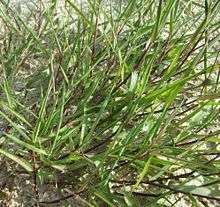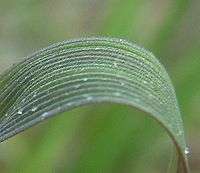Agrostis stolonifera
| Agrostis stolonifera | |
|---|---|
 | |
| Scientific classification | |
| Kingdom: | Plantae |
| (unranked): | Angiosperms |
| (unranked): | Monocots |
| (unranked): | Commelinids |
| Order: | Poales |
| Family: | Poaceae |
| Genus: | Agrostis |
| Species: | A. stolonifera |
| Binomial name | |
| Agrostis stolonifera L., 1753 | |
| Synonyms[2] | |
| |
Agrostis stolonifera (creeping bentgrass, creeping bent, fiorin, spreading bent, carpet bentgrass or redtop[2][3][4]) is a perennial grass species in the Poaceae family.
Description
Agrostis stolonifera is stoloniferous and may form mats or tufts. The prostrate stems of this species grow to 0.4–1.0 metre (1 ft 4 in–3 ft 3 in) long with 2–10-centimetre (0.79–3.94 in) long leaf blades and a panicle reaching up to 40 cm (16 in) in height.
The ligule is pointed and up to 5 millimetres (0.20 in) long. This differs from common bent, Agrostis capillaris, which is short and does not come to a point.
The leaves are tapering, often with a blue-grey colour. The grass is not tufted and the spikelets are red and tightly closed within the panicle.[5] It flowers in July and August.


Distribution
It can be found growing in a variety of habitats including woodlands, grasslands and meadows, wetlands, riparian zones, and as a pioneer species on disturbed sites.[4] It is native to Eurasia and North Africa (Algeria, Morocco and Tunisia). It is possible that it may also be to native to northern parts of North America, and in any case it has been widely introduced and naturalised on that continent and in many other places.[3]
It is a constituent of wet habitats such as marshy grasslands. Some of its species have adapted to contaminated conditions and can cope with heavy metals. It can exist up to 2,500 feet (760 m).[6]
Cultivation
It is the most commonly used species of Agrostis.[7]
The ability of creeping bentgrass to remain palatable and green in the summer is valued for livestock forage; it also provides good cover for upland game birds and waterfowl. It is used for turf in gardens and landscapes, particularly on golf courses.[4] The majority of the putting greens in the USA are creeping bentgrass.
It is also a transgenic crop developed for commercial purpose; the first wind-pollinated and non alimentary herbacea genetically modified. A 2004 gene flow study (with scientific sampling methods) documents gene flow on a landscape level, with a maximum at 21 kilometres (13 mi) and 14 km (8.7 mi) (respectively) in sentinel and resident plants observed by scientist, located in primarily nonagronomic places.[8]
The transgenic creeping bentgrass (Penn A-4 ) overexpressing Avp1 shows improved resistance to salinity stress compared to wild-type controls. The improved performance of the transgenic plants was associated with higher relative water content, higher sodium uptake and lower solute leakage in leaf tissues, with higher concentrations of Na+, K+, Cl- and total phosphorus in root tissues, and with higher auxin accumulation rate in the root tissue. This transgenic plant can survive in the presence of 1.7% sodium chloride (half seawater salinity concentration), while the non transgenic line and wild type plants cannot.[9]
References
- ↑ Lansdown, R.V. (2014). "Agrostis stolonifera". IUCN Red List of Threatened Species. Version 2014.2. International Union for Conservation of Nature. Retrieved 29 August 2014.
- 1 2 PLANTS Profile for Agrostis stolonifera Retrieved 2010-03-16.
- 1 2 Germplasm Resource Information Network Retrieved 2010-03-16.
- 1 2 3 USDA Forest Service Fire Effects Information System Retrieved 2010-03-16.
- ↑ BSBI Description retrieved 2010-11-16.
- ↑ C. E. Hubbard (1978). Grasses. Penguin Books. ISBN 9780140132274.
- ↑ L. Watson; M. J. Dallwitz (2008). "The grass genera of the world: descriptions, illustrations, identification, and information retrieval; including synonyms, morphology, anatomy, physiology, phytochemistry, cytology, classification, pathogens, world and local distribution, and references". The Grass Genera of the World. Retrieved 2009-08-19.
- ↑ Lidia S. Watrud; E. Henry Lee; Anne Fairbrother; Connie Burdick; Jay R. Reichman; Mike Bollman; Marjorie Storm; George King & Peter K. Van de Water. "Evidence for landscape-level, pollen-mediated gene flow from genetically modified creeping bentgrass with CP4 EPSPS as a marker" (PDF). Proceedings of the National Academy of Sciences. 101 (40): 14533–14538. Bibcode:2004PNAS..10114533W. doi:10.1073/pnas.0405154101. PMC 521937
 . PMID 15448206.
. PMID 15448206. - ↑ ZHIGANG LI, Christian M. Baldwin, Qian Hu, Haibo Liu, Hong Luo (2010). Heterologous Expression of Arabidopsis H+-PPase Enhances Salt Tolerance in Transgenic Creeping Bentgrass (Agrostis stolonifera L.). Plant, Cell and Environ, Volume 33 Issue 2, P. 272–289.
